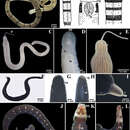en
names in breadcrumbs


Body wall muscle layers either outer circular and inner longitudinal or outer circular, middle longitudinal, and inner circular; ocelli and cerebral organs uncommon; central nervous system primarily external to the body wall musculature but, in some taxa, extending into inner longitudinal muscle layer
(from Allan Hancock Pacific expeditions vol. 2 1935-1940)
Order PALAEONEMERTEA
Key to the Families Represented on Pacific Coast
1. Mouth situated immediately behind brain ; nephridia with single pair of large collecting tubules and efferent ducts.... 2
2. Lateral nerves situated at base of body epithelium or external to circular muscles of body walls, at least in anterior portion of body; internal circular musculature relatively thin; lateral sense organs present ; rhynchocoel vessels absent....Tubulanidae
2. Lateral nerves situated outside muscular layers in anterior portion of esophageal region but imbedded in longitudinal muscles in nephridial region and posteriorly; internal circular musculature enormously developed in nephridial region; lateral sense organs absent; rhynchocoel vessels present....Carinomidae
1. Mouth situated far behind brain ; nephridia with very numerous minute efferent ducts; body filiform; head sharply pointed....Cephalotrichidae
Paleonemertea, Palaeonemertini, Archinemertini
Palaeonemertea is a class of primitive nemertean worm. It may be para- or polyphyletic, consisting of three to five clades and totalling about 100 species.
These worms have several apparently simple features and, as their name suggests, they are often considered to be the most primitive nemerteans. The primary body-wall musculature consists of an outer circular layer overlying a longitudinal layer.
The group includes genera such as Cephalothrix in which the nerve cords are inside the body-wall longitudinal muscle, and Tubulanus, in which the nerve cords are between the outer circular muscle and the epidermis. Tubulanids are commonly encountered in rocky areas of intertidal zones in the northern hemisphere. They are often bright orange or have very distinctive banding and or stripes and can be many metres long, although only a few millimetres thick.
Chernyshev (2021) placed the group in its own superclass Pronemertea, and included the following three orders and six families in the group:[2]
Palaeonemertea is a class of primitive nemertean worm. It may be para- or polyphyletic, consisting of three to five clades and totalling about 100 species.
These worms have several apparently simple features and, as their name suggests, they are often considered to be the most primitive nemerteans. The primary body-wall musculature consists of an outer circular layer overlying a longitudinal layer.
The group includes genera such as Cephalothrix in which the nerve cords are inside the body-wall longitudinal muscle, and Tubulanus, in which the nerve cords are between the outer circular muscle and the epidermis. Tubulanids are commonly encountered in rocky areas of intertidal zones in the northern hemisphere. They are often bright orange or have very distinctive banding and or stripes and can be many metres long, although only a few millimetres thick.